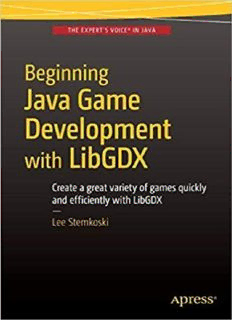Table Of ContentBeginning Java Game
Development with LibGDX
Lee Stemkoski
Beginning Java Game Development with LibGDX
Copyright © 2015 by Lee Stemkoski This work is subject to copyright. All rights are
reserved by the Publisher, whether the whole or part of the material is concerned, specifically
the rights of translation, reprinting, reuse of illustrations, recitation, broadcasting,
reproduction on microfilms or in any other physical way, and transmission or information
storage and retrieval, electronic adaptation, computer software, or by similar or dissimilar
methodology now known or hereafter developed. Exempted from this legal reservation are
brief excerpts in connection with reviews or scholarly analysis or material supplied
specifically for the purpose of being entered and executed on a computer system, for
exclusive use by the purchaser of the work. Duplication of this publication or parts thereof is
permitted only under the provisions of the Copyright Law of the Publisher’s location, in its
current version, and permission for use must always be obtained from Springer. Permissions
for use may be obtained through RightsLink at the Copyright Clearance Center. Violations
are liable to prosecution under the respective Copyright Law.
ISBN-13 (pbk): 978-1-48421501-2
ISBN-13 (electronic): 978-1-4842-1500-5
Trademarked names, logos, and images may appear in this book. Rather than use a trademark
symbol with every occurrence of a trademarked name, logo, or image we use the names,
logos, and images only in an editorial fashion and to the benefit of the trademark owner, with
no intention of infringement of the trademark.
The use in this publication of trade names, trademarks, service marks, and similar terms, even
if they are not identified as such, is not to be taken as an expression of opinion as to whether
or not they are subject to proprietary rights.
While the advice and information in this book are believed to be true and accurate at the date
of publication, neither the authors nor the editors nor the publisher can accept any legal
responsibility for any errors or omissions that may be made. The publisher makes no
warranty, express or implied, with respect to the material contained herein.
Managing Director: Welmoed Spahr Lead Editor: Ben Renow-Clarke
Technical Reviewer: Garry Patchett Editorial Board: Steve Anglin, Pramila Balan,
Louise Corrigan, Jonathan Gennick, Robert Hutchinson, Celestin Suresh John,
Michelle Lowman, James Markham, Susan McDermott, Matthew Moodie,
Jeffrey Pepper, Douglas Pundick, Ben Renow-Clarke, Gwenan Spearing
Coordinating Editor: Mark Powers Copy Editor: Sharon Wilkey
Compositor: SPi Global
Indexer: SPi Global
Artist: SPi Global
Distributed to the book trade worldwide by Springer Science+Business Media New York,
233 Spring Street, 6th Floor, New York, NY 10013. Phone 1-800-SPRINGER, fax (201) 348-
4505, e-mail [email protected], or visit
www.springeronline.com. Apress Media, LLC is a California LLC and the sole
member (owner) is Springer Science + Business Media Finance Inc (SSBM Finance Inc).
SSBM Finance Inc is a Delaware corporation.
For information on translations, please e-mail [email protected], or visit
www.apress.com.
Apress and friends of ED books may be purchased in bulk for academic, corporate, or
promotional use. eBook versions and licenses are also available for most titles. For more
information, reference our Special Bulk Sales–eBook Licensing web page at
www.apress.com/bulk-sales.
Any source code or other supplementary materials referenced by the author in this text is
available to readers at www.apress.com/9781484215012. For detailed information
about how to locate your book’s source code, go to www.apress.com/source-code/.
Readers can also access source code at SpringerLink in the Supplementary Material section
for each chapter.
Contents at a Glance
About the Author
About the Technical Reviewer
Acknowledgments
Introduction
Chapter 1: Getting Started with Java and
LibGDX
Chapter 2: The LibGDX Framework
Chapter 3: Extending the Framework
Chapter 4: Adding Polish to Your Game
Chapter 5: Alternative Sources of User Input
Chapter 6: Additional Game Case Studies
Chapter 7: Integrating Third-Party Software
Chapter 8: Introduction to 3D Graphics
Chapter 9: The Journey Continues
Appendix A: Review of Java Fundamentals
Index
Contents
About the Author
About the Technical Reviewer
Acknowledgments
Introduction
Chapter 1: Getting Started with Java and
LibGDX
Choosing a Development Environment
Setting Up BlueJ
Downloading and Installing
Using BlueJ
Setting Up LibGDX
Creating a “Hello, World!” Program with LibGDX
Advantages to Using LibGDX
Summary
Chapter 2: The LibGDX Framework
Understanding the Life Cycle of a Game
Working with User Input
Managing the Action
The Sprite Class
The Actor Class
Implementing Visual Effects
Value-Based Animations
Image-Based Animations
Introducing User Interfaces
Labels and Bitmap Fonts
Layering with Stage Objects
Cameras and Scrolling
Handling Multiple Screens
Summary
Chapter 3: Extending the Framework
Cheese, Please! Revisited
Discrete Input
Abstract Class Design
Refactoring the Project
Balloon Buster: A Mouse-Driven Game
Balloons
Adding Interactivity
Next Steps
Starfish Collector: A Game with Improved Actor
Classes
The BaseActor Class
The AnimatedActor Class
The PhysicsActor Class
Creating the Game
Next Steps
Summary
Chapter 4: Adding Polish to Your Game
Audio
Advanced User-Interface Design
Arranging UI Elements
Managing Resources
Using Customized Bitmap Fonts
Creating Buttons
Setting Up the Start Screen
Creating an Overlay Menu
Summary
Chapter 5: Alternative Sources of User Input
Gamepad Controllers
Continuous Input
Discrete Input
Touch-Screen Controls
Working with a Touch Pad
Redesigning the User Interface
Summary
Chapter 6: Additional Game Case Studies
Space Rocks
The Spaceship
Lasers
Rocks and Explosions
Next Steps
Plane Dodger
Infinite Scrolling Effects
Player Plane
Stars and Sparkles
Enemy Planes
Next Steps
Rectangle Destroyer
The Paddle
The Brick
The Ball
The Power-up
Setting Up the Game
Next Steps
52-Card Pickup
Cards and Piles
Description:Beginning Java Game Development with LibGDX covers the design and creation of video games using the Java programming language, with the LibGDX software library. By reading this book, you will learn how to design video games and how to build them in Java. You will be able to create your own 2D games,

